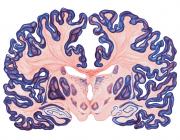Visual responses of the human superior colliculus: a high-resolution functional magnetic resonance imaging study.
Publication Year
2005
Type
Journal Article
Abstract
The superior colliculus (SC) is a multimodal laminar structure located on the roof of the brain stem. The SC is a key structure in a distributed network of areas that mediate saccadic eye movements and shifts of attention across the visual field and has been extensively studied in nonhuman primates. In humans, it has proven difficult to study the SC with functional MRI (fMRI) because of its small size, deep location, and proximity to pulsating vascular structures. Here, we performed a series of high-resolution fMRI studies at 3 T to investigate basic visual response properties of the SC. The retinotopic organization of the SC was determined using the traveling wave method with flickering checkerboard stimuli presented at different polar angles and eccentricities. SC activations were confined to stimulation of the contralateral hemifield. Although a detailed retinotopic map was not observed, across subjects, the upper and lower visual fields were represented medially and laterally, respectively. Responses were dominantly evoked by stimuli presented along the horizontal meridian of the visual field. We also measured the sensitivity of the SC to luminance contrast, which has not been previously reported in primates. SC responses were nearly saturated by low contrast stimuli and showed only small response modulation with higher contrast stimuli, indicating high sensitivity to stimulus contrast. Responsiveness to stimulus motion in the SC was shown by robust activations evoked by moving versus static dot stimuli that could not be attributed to eye movements. The responses to contrast and motion stimuli were compared with those in the human lateral geniculate nucleus. Our results provide first insights into basic visual responses of the human SC and show the feasibility of studying subcortical structures using high-resolution fMRI.
Keywords
Journal
J Neurophysiol
Volume
94
Pages
2491-503
Date Published
10/2005
ISSN Number
0022-3077
Alternate Journal
J. Neurophysiol.
PMID
15944234

